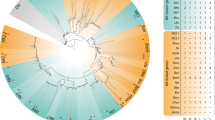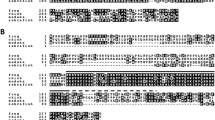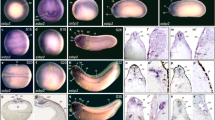Abstract
We describe the phylogenetic analysis and expression pattern of the Xenopus radial spoke protein 3 (RSP3) gene during early development. The Xenopus RSP3 protein presents characteristic features of the RSP3 family. It contains a radial spoke domain, which is 75 and 72 % identical to the corresponding region of human and Chlamydomonas RSP3 proteins, respectively. Examination of the phylogenetic relationship between the Xenopus RSP3 protein and its known homologues from different deuterostomes indicates that the RSP3 proteins are highly conserved among deuterostomes. Whole-mount in situ hybridization analyses show that Xenopus RSP3 is a maternal mRNA enriched in the animal hemisphere during cleavage stages. The expression is detected in the dorsal region of the embryo during gastrulation, then in the presumptive neuroectoderm at the end of gastrulation. During neurulation and at the subsequent stages, the expression of RSP3 mRNA is detected in the entire multiciliated cells of epidermis. At tail-bud stages, it is progressively expressed in the otic vesicles and sequentially expressed in the nephrostomes. Expression could be also detected in the floor plate of the neural tube. This expression pattern persists until at least late tail-bud stages.



Similar content being viewed by others
References
Barber CF, Heuser T, Carbajal-González BI, Botchkarev VV Jr, Nicastro D (2011) Three-dimensional structure of the radial spokes reveals heterogeneity and interactions with dyneins in Chlamydomonas flagella. Mol Biol Cell 23:111–120
Basu B, Brueckner M (2008) Cilia multifunctional organelles at the center of vertebrate left-right asymmetry. Curr Top Dev Biol 85:151–174
Bourdelas A, Li HY, Carron C, Shi DL (2009) Dynamic expression pattern of distinct genes in the presomitic and somitic mesoderm during Xenopus development. Int J Dev Biol 53:1075–1079
Blum M, Beyer T, Weber T, Vick P, Andre P, Bitzer E, Schweickert A (2009) Xenopus, an ideal model system to study vertebrate left–right asymmetry. Dev Dyn 238:1215–1225
Fliegauf M, Benzing T, Omran H (2007) When cilia go bad: cilia defects and ciliopathies. Mol Cell Biol 8:880–893
Gaillard AR, Diener DR, Rosenbaum JL, Sale WS (2001) Flagellar radial spoke protein 3 is an A-kinase anchoring protein (AKAP). J Cell Biol 153:443–448
Jivan A, Earnest S, Juang YC, Cobb MH (2009) Radial spoke protein 3 is a mammalian protein kinase A-anchoring protein that binds ERK1/2. J Biol Chem 284:29437–29445
Kong WH, Yang YJ, Zhang TX, Shi DL, Zhang YJ (2012) Characterization of sFRP2-like in amphioxus: insights into the evolutionary conservation of Wnt antagonizing function. Evol Dev 14:168–177
Koukoulas I, Augustine C, Silkenbeumer N, Gunnersen JM, Scott HS, Tan SS (2004) Genomic organisation and nervous system expression of radial spoke protein 3. Gene 336:15–23
Li HY, Bourdelas A, Carron C, Shi DL (2010) The RNA-binding protein Seb4 is a target of MyoD and is required for myogenesis during Xenopus early development. Mech Dev 127:281–291
Mizuno N, Taschner M, Engel BD, Lorentzen E (2012) Structural studies of ciliary components. J Mol Biol 422:163–180
Park TJ, Mitchell BJ, Abitua PB, Kintner C, Wallingford JB (2008) Dishevelled controls apical docking and planar polarization of basal bodies in ciliated epithelial cells. Nat Genet 40:871–879
Pigino G, Ishikawa T (2012) Axonemal radial spokes: 3D structure, function and assembly. Bioarchitecture 2:50–58
Raciti D, Reggiani L, Geffers L, Jiang Q, Bacchion F, Subrizi AE, Clements D, Tindal C, Davidson DR, Kaissling B, Brändli AW (2008) Organization of the pronephric kidney revealed by large-scale gene expression mapping. Genome Biol 9:R84
Saulnier DM, Ghanbari H, Brändli AW (2002) Essential function of Wnt-4 for tubulogenesis in the Xenopus pronephric kidney. Dev Biol 248:13–28
Vick P, Schweickert A, Weber T, Eberhardt M, Mencl S, Shcherbakov D, Beyer T, Blum M (2009) Flow on the right side of the gastrocoel roof plate is dispensable for symmetry breakage in the frog Xenopus laevis. Dev Biol 331:281–291
Werner ME, Mitchell BJ (2012) Understanding ciliated epithelia: the power of Xenopus. Genesis 50:176–185
Wessely O, Obara T (2008) Fish and frogs: models for vertebrate cilia signaling. Front Biosci 13:1866–1880
Yang P, Diener DR, Yang C, Kohno T, Pazour GJ, Dienes JM, Agrin NS, King SM, Sale WS, Kamiya R, Rosenbaum JL, Witman GB (2006) Radial spoke proteins of Chlamydomonas flagella. J Cell Sci 119:1165–1174
Acknowledgments
This work was supported by grants from the Association Française contre les Myopathies and the Agence Nationale de la Recherche (ANR-09-BLAN-0262-03) to D.L.S. and the National Natural Science Foundation of China (30470902) and the Natural Science Foundation of Shandong (Y2007D13) to Y.J.Z. We thank X. Guo and X. Song for illustrations.
Author information
Authors and Affiliations
Corresponding author
Additional information
Communicated by T. Hollemann
Rights and permissions
About this article
Cite this article
Zhang, YJ., Zhao, L., Meng, YP. et al. Xenopus radial spoke protein 3 gene is expressed in the multiciliated cells of epidermis and otic vesicles and sequentially in the nephrostomes. Dev Genes Evol 223, 183–188 (2013). https://doi.org/10.1007/s00427-012-0433-5
Received:
Accepted:
Published:
Issue Date:
DOI: https://doi.org/10.1007/s00427-012-0433-5




